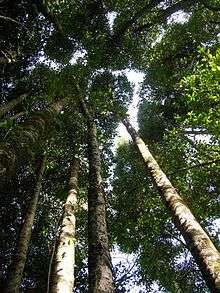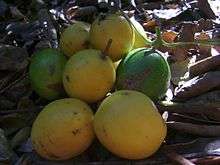Gomortega
Gomortega keule (syn. G. nitida; Spanish names keule, queule, and hualhual) is a tree native to Chile. It is the sole species of the genus Gomortega and, according to the APG IV system of 2016 (unchanged from the APG systems of 2009, 2003 and 1998), of the monotypic family Gomortegaceae, assigned to the order Laurales in the clade magnoliids.[3]
| Gomortega | |
|---|---|
 | |
| Gomortega keule in Biobío Region | |
| Scientific classification | |
| Kingdom: | Plantae |
| Clade: | Tracheophytes |
| Clade: | Angiosperms |
| Clade: | Magnoliids |
| Order: | Laurales |
| Family: | Gomortegaceae Reiche[2] |
| Genus: | Gomortega Ruiz & Pav. |
| Species: | G. keule |
| Binomial name | |
| Gomortega keule | |
| Synonyms | |
|
Adenostemum nitidum (Ruiz & Pav.) Pers. | |
Description

Evergreen trees, aromatic, gray bark with shallow longitudinal fissures. The leaves are deciduous, petiolate, simple, entire, obovate to lanceolate, coriaceous. The stems have unilacunar nodes and with two foliar traces. The branches are quadrangular.
The fruit is a uni or trilocular yellow drupe, usually with 1 (-2) seeds, fleshy mesocarp, pleasant, stony endocarp. There are 1-2 seeds per fruit, with abundant, oily endosperm, large embryo, dicotyledonous.
The chromosome number is n = 21, 2n = 42.
Distribution
The plant grows only in a very narrow habitat range in coastal central Chile, with an example ecoregion of occurrence being the Chilean matorral.[4] The species is endangered of extinction due to overharvesting, clearing the forests where it is found for agriculture and silviculture.
Gomortega keule produces a yellow edible sweet fruit about 34–45 millimetres (1.3–1.8 in) in diameter, harvested for making a kind of marmalade.
References
- Echeverría, C. & Campos, S. (2019). "Gomortega keule". IUCN Red List of Threatened Species. 2019: e.T31357A2805379. doi:10.2305/IUCN.UK.2019-2.RLTS.T31357A2805379.en. Retrieved July 11, 2020.CS1 maint: multiple names: authors list (link)
- Angiosperm Phylogeny Group (2009). "An update of the Angiosperm Phylogeny Group classification for the orders and families of flowering plants: APG III". Botanical Journal of the Linnean Society. 161 (2): 105–121. doi:10.1111/j.1095-8339.2009.00996.x.
- Angiosperm Phylogeny Group (2016). "An update of the Angiosperm Phylogeny Group classification for the orders and families of flowering plants: APG IV". Botanical Journal of the Linnean Society. 181 (1): 1–20. doi:10.1111/boj.12385. ISSN 0024-4074.CS1 maint: uses authors parameter (link)
- C. Michael Hogan & World Wildlife Fund. 2013. Chilean matorral. ed. M.McGinley. Encyclopedia of Earth. National Council for Science and the Environment. Washington DC
External links


The species
- Gomortega keule in Encyclopedia of the Chilean Flora
- Information on Gomortega keule (in Spanish)
- González (1998). "Gomortega keule". IUCN Red List of Threatened Species. 1998. Retrieved 11 May 2006.CS1 maint: ref=harv (link) Listed as Endangered (EN A1cd v2.3)
- Pictures and habitat map of Gomortega keule (in Spanish)
- Project developed in Chile on Gomortega keule (in Spanish)
- (in Spanish)
The family
- Gomortegaceae in L. Watson and M.J. Dallwitz (1992 onwards). The families of flowering plants: descriptions, illustrations, identification, information retrieval. Version: 27 April 2006. http://delta-intkey.com.
- e-floras
- NCBI Taxonomy Browser
- links at CSDL, Texas
